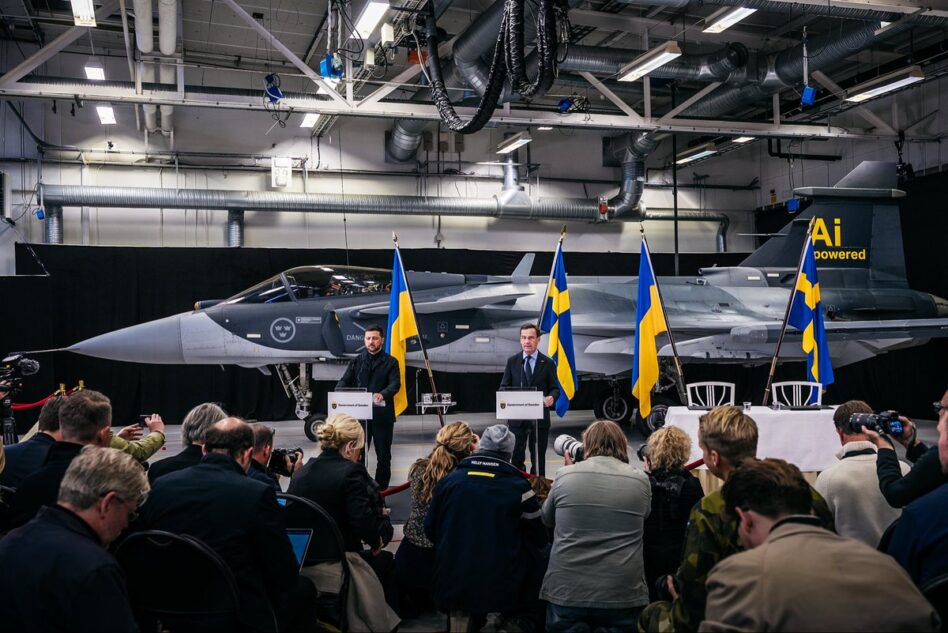Trump may be waffling on Tomahawks, but at least the Swedes are there for Ukraine. Yesterday, Ukrainian President Volodymyr Zelenskyy and Swedish Prime Minister Ulf Kristersson signed a letter of understanding signaling that the Nordic country could sell Kyiv up to 150 of its most advanced fighter jets, the Saab Gripen-E.
Kristersson hinted that financing for the deal could come from frozen Russian assets held in European and allied nations (seems to be a bit of a trend these days).
“We fully realize it’s a long road ahead of us … But from today we are committed to exploring all the possibilities in providing Ukraine with a large amount of Gripen fighters in the future,” he said.
Details of the deal, including the exact number of jets that will be sold, remain murky—it is just an LoU after all. But Zelenskyy said that his country aims to receive and field Gripens as soon as next year. “For our army, Gripens are a priority. It is about money, about maneuvers,” he said to reporters.
Fighter jets have been a bit of a touchy subject for Ukraine. Basically, since the start of the war in 2022, Kyiv has said that it needs advanced fighters to win a conflict with Russia. But Western allies—including the United States—have been pretty slow to send over these high-end planes.
- In 2023, neighboring states began to send over some Soviet-era MiG-29s, mostly ex-Warsaw Pact fighters that the Ukrainians could use (or break down for parts) fast.
- The US and European allies started setting up the infrastructure for Ukrainian use of F-16s—including training—in 2023. The first jets (usually older models sourced from European countries) arrived and were fielded by Ukraine in mid-2024.
- France sent over some Mirage-2000-5s (made by Dassault Aviation) earlier this year. European countries have also continued to send over more F-16s, with even more promised. In total, about 85 F-16s have been promised and over a dozen delivered (exact numbers are not public).
These fighters have helped a lot with Ukraine’s air defense—they’ve got way more advanced radar and missile packages than what Kyiv had on hand—but a few have reportedly been lost (expected, tbh) and sustainment (repairs, ground crews, spare parts, etc.) has been less than ideal.
Experts argue that the Gripen-E, however, could be a game-changer for Ukrainian forces.
- The advanced fighter can take off and land on civilian roads (rather than just runways), meaning it can be fielded in super out-of-the-way places—like, say, eastern Ukraine.
- Gripen-Es also have a pretty low maintenance footprint—a crew of five or so and a truck can refuel, rearm, and relaunch a jet in about ten minutes. That’s a better fit for the way (and the speed at which) Ukrainian forces work.
- The Gripen-E has a pretty sweet EW suite (ha-ha), meaning it can both survive in contested environments and jam the Russians.
- It’s also cheaper to fly per hour than other fighter jets (Nordic fuel efficiency, baby) and can carry both Western and legacy munitions—including Meteor air-to-air missiles.
So far, the issue with getting Gripen-Es to Ukraine has had a lot to do with production capacity, but Saab—and the Swedes—are now ramping things up. Sweden has ordered 60 Gripen-Es, and Saab is increasing production at its Linkoping plant to be able to produce 20-30 jets a year. They’re also setting up a production line in Brazil.
“We are opening an entirely new and truly meaningful chapter in our relations — relations between Ukraine and Sweden, and more broadly, overall security relations in Europe,” Zelenskyy said in a post on X.
Let’s see who sends over planes next.

